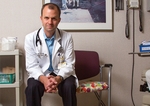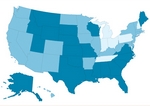Profession

More than 45 million Americans received a swine flu vaccine in 1976. But the immunization campaign ended abruptly when there were unexplained deaths and reports of Guillain-Barré syndrome among recipients. A link was never proven. This year, federal agencies are working with physicians and patients nationwide to track and investigate any reports of adverse events. One national study is designed to monitor people who receive the vaccine for up to six weeks postimmunization.
H1N1 vaccine to be tracked for safety concerns
■ Health officials hope physicians will report any adverse reactions that could be related to the vaccine.
By Susan J. Landers — Posted Oct. 12, 2009
- WITH THIS STORY:
- » External links
- » Related content
Federal health officials want to harness the clinical observations of physicians to an unprecedented tracking system to help monitor the safety of the influenza A(H1N1) vaccine.
The Dept. of Health and Human Services and the Centers for Disease Control and Prevention have beefed up existing surveillance systems and are launching new ones -- all designed to pick up any adverse reactions to the flu vaccine as soon as possible. They are urging physicians to participate by reporting any events they see.
"It will be important to determine whether medical events are caused by the vaccine or whether they just happened to occur," said Bruce Gellin, MD, MPH, director of HHS's National Vaccine Program Office. The efforts are aimed at "making sure the public has as much confidence in the medical system as we do," he said during a Sept. 30 presentation on vaccine safety.
Although officials are leaving it to physicians' clinical judgment as to which events rise to reportable levels, they particularly are interested in learning about any possible cases of Guillain-Barré syndrome.
A slight increase in the neurological syndrome was believed to be associated with the 1976 swine flu vaccine, but a link was never proven. Swine flu vaccine was administered to more than 45 million Americans in 1976, but unexplained deaths among people who received the vaccine and reports of Guillain-Barré ended the campaign abruptly.
The tracking methods now being implemented range from increased staffing at the Vaccine Adverse Events Reporting System to a new nationwide study designed to actively monitor vaccine recipients for up to six weeks postvaccination. The stepped-up surveillance is intended to allay public concerns that the new vaccine was rushed through production and may carry a heightened risk of side effects.
"What I want people to know is that no corners have been cut at all," said Anne Schuchat, MD, director of the National Center for Immunization and Respiratory Diseases. "H1N1 vaccine is being produced exactly the same way that the seasonal flu vaccine is produced, with exactly the same oversight."
According to federal data gathered over 15 years, 24 adverse events were reported for every million doses of annual flu vaccine. Those events included fever and muscle soreness in children and adults, and seizures in children.
Concerns raised about H1N1 vaccine
The message that the vaccine appears safe for almost everyone may not be getting across -- even as the vaccine arrives in states and cities and mass vaccination programs are set to begin.
A study released Oct. 2 by Harvard School of Public Health researchers found that only 40% of adults were "absolutely certain" they would get the H1N1 vaccine for themselves and 51% of parents were "absolutely certain" they would get the vaccine for their children. Children are among the designated priority groups to receive the vaccine.
But if the flu outbreak is severe in their own communities, those queried told researchers they might be more inclined to get the vaccine for themselves and their children. The survey was conducted Sept. 14-20 by telephone with a sample of 1,042 adults.
Those who were not "absolutely certain" they would get the H1N1 vaccine said they were concerned about possible side effects, did not think they were at risk of getting seriously ill from the virus or thought they could get medication to treat H1N1 if they got sick.
By late September, widespread H1N1 activity had been reported in 27 states, and the virus' spread showed no signs of slowing, according to the CDC. If the increasing reach of the illness prompts more people to get the vaccine, tracking systems will help determine if anything unusual occurs.
VAERS, which is jointly managed by the CDC and the Food and Drug Administration, is ready to receive reports of events from physicians and others, said Claudia Vellozzi, MD, MPH, deputy director of the CDC's Immunization Safety Office. Staff is being increased for the upcoming flu season to process reports more rapidly, she said.
But there are limitations to VAERS, Dr. Vellozzi said. The quality of the data varies, and there is no unvaccinated comparison group. There also is a great deal of underreporting, she said.
Some other tracking efforts include the Vaccine Safety Datalink project, a joint effort involving the CDC's Immunization Safety Office and eight large managed care organizations.
A new tracking system, the Real Time Immunization Monitoring System, will use a Web-based system developed at Johns Hopkins Bloomberg School of Public Health to follow people for up to six weeks postvaccination.
The CDC and six academic medical centers with vaccine safety experts will provide clinical expertise in the evaluation of serious adverse events. The Dept. of Defense is monitoring 1.5 million active duty personnel. Another tracking component is Post-Licensure Rapid Immunization Safety Monitoring, a collaboration involving the National Vaccine Program Office, the FDA and the CDC.
About 600,000 doses of the nasal-spray H1N1 vaccine have been shipped and scheduled to arrive in early October in 25 states and cities, Dr. Schuchat said. Injectable vaccine was expected to be shipped soon after that.












